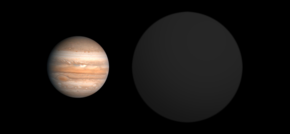 Size comparison of WASP-12b (right) with Jupiter | |
| Discovery | |
|---|---|
| Discovery site | SAAO |
| Transit | |
| Orbital characteristics | |
| Aphelion | 15,000,000 mi |
| Perihelion | 2,000,000 mi |
| Periastron | 0.0218 |
| 0.0229 ± 0.0008 | |
| Eccentricity | 0.049 ± 0.015 |
| 1.091423 ± 3e-6 | |
| Inclination | 83.1+1.4 −1.1 |
| -74+13 −10 | |
| Star | WASP-12 |
| Physical characteristics | |
| Mass | 1.35 ± 0.14 |
Mean density | 326 |
WASP-12b is an extrasolar planet orbiting the star WASP-12, discovered by the SuperWASP planetary transit survey. Its discovery was announced on April 1, 2008.[1] Due to its extremely close orbit to its star, it has one of the lowest densities for exoplanets ('inflated' by the flux of energy from the star). The planet takes only a little over a day to orbit the star, in contrast to 365 days for the Earth to orbit the Sun. Its distance from the star (approximately 2,115,000 miles) is only 1/44 the Earth’s distance from the Sun, with an eccentricity the same as Jupiter's. On 3 December 2013, scientists working with the Hubble Space Telescope reported detecting water in the atmosphere of the exoplanet.[3][4]
In July, 2014, NASA announced finding very dry atmospheres on three exoplanets (HD 189733b, HD 209458b, WASP-12b) orbiting sun-like stars.[5]
Characteristics edit
The planet is so close to WASP-12 that the star's tidal forces are distorting it into an egg shape and pulling away its atmosphere at a rate of about 10−7 MJ (about 189 quadrillion tonnes) per year.[6] The so-called "tidal heating", and the proximity of the planet to its star, combine to bring the surface temperature to more than 2,500 K (2,200 °C).
On May 20, 2010, the Hubble Space Telescope spotted WASP-12b being "consumed" by its star. Scientists had been aware that stars could consume planets; however, this was the first time such an event had been observed so clearly. NASA has estimated that the planet has 10 million years left of its life.[7]
The Hubble Space Telescope observed the planet by using its Cosmic Origins Spectrograph (COS). The observations have confirmed predictions published in Nature in February 2009 by Peking University's Shu-lin Li. The planet's atmosphere has ballooned to be nearly three times the radius of Jupiter, while the planet itself has 40% more mass than Jupiter.
Carbon content edit
Recent evidence indicates that WASP-12b has an enhanced carbon-to-oxygen ratio, significantly higher than that of the Sun, indicating that it is a carbon-rich gas giant. The C/O ratio compatible with observations is about 1, while the solar value is 0.54. The C/O ratios suggest that carbon-rich planets may have formed in the star system.[8] One of the researchers behind that study commented that "with more carbon than oxygen, you would get rocks of pure carbon, such as diamond or graphite".[9]
The published study states: "Although carbon-rich giant planets like WASP-12b have not been observed, theory predicts myriad compositions for carbon-dominated solid planets. Terrestrial-sized carbon planets, for instance, could be dominated by graphite or diamond interiors, as opposed to the silicate composition of Earth."[8] These remarks have led the media to pick up on the story,[10] some even calling WASP-12b a "diamond planet".[11]
The carbon content of the planet is located within its atmosphere, in the form of carbon monoxide and methane. The study appears in the journal Nature.[12]
Candidate satellite edit
Russian astronomers studying a curve of change of shine of the planet observed splashes of light indicative of an extrasolar moon orbiting the planet.[13]
See also edit
References edit
- ^ a b c "The Planets". SuperWASP. Retrieved 2008-09-26.
- ^ Cite error: The named reference
oasiswas invoked but never defined (see the help page). - ^ Staff (3 December 2013). "Hubble Traces Subtle Signals of Water on Hazy Worlds". NASA. Retrieved 4 December 2013.
- ^ Mandell, Avi M.; Haynes, Korey; Sinukoff, Evan; Madhusudhan, Nikku; Burrows, Adam; Deming, Drake (3 December 2013). "Exoplanet Transit Spectroscopy Using WFC3: WASP-12 b, WASP-17 b, and WASP-19 b". Astrophysical Journal. 779 (2): 128. arXiv:1310.2949. Bibcode:2013ApJ...779..128M. doi:10.1088/0004-637X/779/2/128. Retrieved 4 December 2013.
- ^ Harrington, J.D.; Villard, Ray (July 24, 2014). "RELEASE 14-197 - Hubble Finds Three Surprisingly Dry Exoplanets". NASA. Retrieved July 25, 2014.
- ^ Li, Shu-lin; Miller, N.; Lin, Douglas N. C.; Fortney, Jonathan J. (2010). "WASP-12b as a prolate, inflated and disrupting planet from tidal dissipation". Nature. 463 (7284): 1054–1056. arXiv:1002.4608. Bibcode:2010Natur.463.1054L. doi:10.1038/nature08715. PMID 20182506.
{{cite journal}}: Unknown parameter|lastauthoramp=ignored (|name-list-style=suggested) (help) - ^ Hubble Finds a Star Eating a Planet nasa.gov. 2010-05-20. Retrieved on 2010-12-10.
- ^ a b Madhusudhan, N.; Harrington, J.; Stevenson, K. B.; Nymeyer, S.; Campo, C. J.; Wheatley, P. J.; Deming, D.; Blecic, J.; Hardy, R. A.; Lust, N. B.; Anderson, D. R.; Collier-Cameron, A.; Britt, C. B. T.; Bowman, W. C.; Hebb, L.; Hellier, C.; Maxted, P. F. L.; Pollacco, D.; West, R. G. (2010). "A high C/O ratio and weak thermal inversion in the atmosphere of exoplanet WASP-12b". Nature. 469 (7328): 64–67. arXiv:1012.1603. Bibcode:2011Natur.469...64M. doi:10.1038/nature09602. PMID 21150901.
- ^ "Carbon-Rich Planet: A Girl's Best Friend?". U.S. News & World Report. 10 December 2010.
- ^ Lorianna De Giorgio (10 December 2010). "Carbon-rich planet could house diamonds". Toronto Star.
- ^ "Diamond planet found by Keele University astronomers". BBC News Online. 9 December 2010.
- ^ Intagliata, Christopher (December 9, 2010). "Exoplanet Strikes Carbon Pay Dirt". Scientific American.
- ^ Российские астрономы впервые открыли луну возле экзопланеты (in Russian) - "Studying of a curve of change of shine of WASP-12b has brought to the Russian astronomers unusual result: regular splashes were found out.<...> Though stains on a star surface also can cause similar changes of shine, observable splashes are very similar on duration, a profile and amplitude that testifies for benefit of exomoon existence."
External links edit
Media related to WASP-12b at Wikimedia Commons